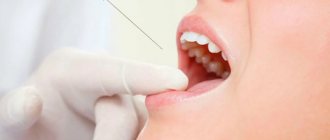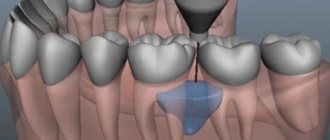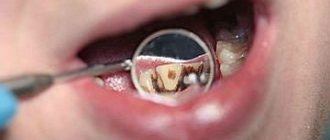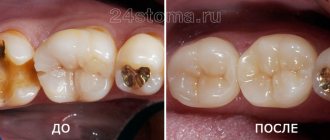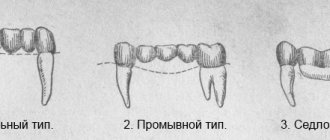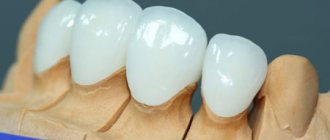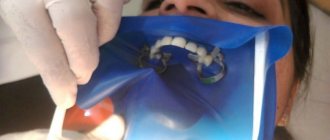From this article you will learn:
- anesthesia in dentistry - drugs,
- types of anesthesia for dental treatment,
- pain relief during pregnancy and breastfeeding.
The article was written by a dental surgeon with more than 19 years of experience.
Local anesthesia is a type of anesthesia, the meaning of which is to block the transmission of pain impulses from the area where the intervention is performed. Options for local anesthesia in dentistry include infiltration, conduction or application anesthesia. They allow you to anesthetize only the area where the intervention is planned (this could be a group of teeth or a fragment of the jaw), while the patient is conscious.
To carry out local anesthesia in dentistry, medications are used that are called “local anesthetics”. But in some cases, for example, during extensive surgical interventions or a person’s panicky fear of treatment or tooth extraction, general anesthesia can also be used, in which, along with pain sensitivity, the patient’s consciousness is temporarily turned off. General anesthesia is carried out using narcotic analgesics administered intravenously or inhaled (Fig. 3).
Local and general anesthesia in dentistry –
The very first local anesthetic in dentistry was novocaine, which, however, did not allow for significant anesthesia and practically did not anesthetize inflamed tissues. Later, lidocaine appeared, which was already about 2-2.5 times stronger in effectiveness, but like novocaine, it did not allow achieving a great depth and duration of anesthesia. A real revolution occurred with the advent of articaine anesthetics (based on articaine hydrochloride), which additionally contained vasoconstrictors.
The most popular local anesthetics in dentistry based on articaine are Ultracaine, Ubistezin, Alfacaine, Septanest and others. To further increase the depth and duration of anesthesia, vasoconstrictors began to be added to these drugs. The latter constrict the blood vessels at the site of injection of the anesthetic, thereby reducing the rate of its leaching from the tissues. Currently, epinephrine is most often used as a vasoconstrictor at a concentration of 1:100,000 and 1:200,000.
Methods of pain relief in dentistry
Local anesthesia
Considered the safest. It affects only the peripheral nervous system (does not turn off a person’s consciousness). After administration of the analgesic, a feeling of numbness occurs in the gums, tongue and lips. Over time, the anesthetic breaks down and sensitivity is restored. Used for all types of therapeutic and surgical procedures in dentistry.
General anesthesia (anesthesia)
General anesthesia puts a person into a state of deep sleep, turning off consciousness.
For this purpose, narcotic analgesics (Sevoran, Xenon) are used. They are administered intravenously or through a face mask (inhalation). This type of pain relief is indicated in dentistry for complex surgical operations, as well as in the case of dental phobia (fear of dental treatment).
Another indication for general anesthesia is an allergy to local anesthetic drugs.
Sedation
Sedation (superficial sleep) is an alternative to anesthesia. This method relieves emotional stress and relaxes a person. But at the same time, the patient is conscious and able to follow all the doctor’s instructions. Nitrous oxide is used as a sedative. This is an anesthetic gas that must be inhaled through a nasal mask.
Advantages
By comparing conduction anesthesia and alternative methods of anesthesia, one can discover undeniable advantages in this type:
- anesthesia of a larger and deeper area of the jaw , which makes it possible to remove several teeth or tumors, or to open an abscess;
- Less painkiller required ;
- longer (up to 3 hours) blockade period ;
- safety due to the ability to control the administration of anesthetic;
- minimal number of complications;
- the body recovers faster;
- in the drugs used, adrenaline is absent or present in minimal quantities , which makes it possible to administer them to a wider range of patients.
Considering that the injected anesthetic solutions act simultaneously on autonomic and sensory nerve fibers, pain relief is accompanied by less salivation. This improves the doctor's working conditions.
All the names of antibiotics for toothache and which ones are the most effective according to dentists. From this article you will learn about the need to sanitize the oral cavity before surgery.
At this address https://dr-zubov.ru/lechenie/bolezni-polosti-rta/tonzillita-v-domashnix-usloviyax.html read about the symptoms and treatment of tonsillitis at home.
Types of local anesthesia in dentistry
Application anesthesia
This is a superficial anesthesia that is performed without an injection. The doctor treats the gums with a gel or spray based on lidocaine, after which the sensitivity of the mucous membrane decreases. The method is used to treat periodontitis, clean gum pockets (ultrasonic scaling), and also to remove highly mobile teeth.
Injection (carpule)
The anesthetic solution is injected under the mucous membrane using an injection (injection). For this purpose, carpule syringes with thin needles are used. The dosage of the drug is selected individually depending on the patient’s health status, age and weight. As a rule, one carpule (1.7 ml) or half is enough.
The drug begins to act 2-3 minutes after administration.
There are several types of injection anesthesia in dentistry:
- infiltration - the injection is made in the projection area of the apex of the tooth root. As a result of diffusion, the anesthetic spreads to the branching area of the dental nerve, as well as to the jaw bone;
- conductive - used to anesthetize several teeth at once, the drug is injected into the area of the trigeminal nerve;
- intraosseous - performed before complex tooth extraction, the anesthetic is injected directly into the spongy bone between 2 teeth;
- intraligamentous - the injection is made into the periodontal ligament or into the gingival sulcus, so this method is considered more comfortable. Most often used for children;
- stem - the most powerful type of anesthesia, the anesthetic is injected at the base of the skull to “freeze” the stem nerves of the upper and lower jaw. It is used before complex surgical operations on the jaw.
Methods of administering conduction anesthesia
Methods of administering conduction anesthesia can be divided into 2 groups:
- Extraoral. Used in the presence of inflammatory foci in the oral cavity. These include:
- Submandibular. The pain medication blocks the inferior alveolar nerve.
- Podzykulova. The drug is injected under the edge of the cheekbone arch.
- Mandibular. The mandibular foramen loses sensitivity.
Once the anesthetic is injected into the treated area, the numbing effect occurs within 15 minutes. The duration of the anesthetic effect depends on the type of medication used.
- Intraoral. These include:
- Apodactylous. The alveolar nerve is blocked.
- Torusal. The anesthetic is injected into the mandibular ridge. Molars and premolars lose sensitivity.
- Tuberal. Anesthesia is injected into the area of the molars located on the upper jaw.
- Infraorbital. It is used to block sensitivity in the anterior wall of the maxillary bone, mucous membrane and alveolar process.
- Palatine. The palate and alveolar process are anesthetized.
- Incisive. The anesthetic is injected between the upper canine and incisor. The hard palate, nasopalatine nerve and soft tissues surrounding the tooth become numb.
When administered intraorally, the effect occurs 10 minutes after injection.
Preparation for conduction anesthesia
Before performing the operation under general anesthesia, it is necessary to undergo a standard examination. During diagnosis, special attention should be paid to the patient’s neurological condition, his psyche and behavior.
Before the procedure, the specialist will explain in simple, accessible words about the sequence and method of administering anesthesia, as well as the sensations that may accompany the patient during pain relief. In addition, the doctor will definitely check the patient’s reaction to the anesthetic drug to make sure there is no allergic reaction.
The anesthesiologist must follow the rules when administering conduction anesthesia:
- First of all, it is necessary to numb the skin using a gentle method.
- The needle must be fixed in a strictly defined place in order for the anesthetic to reach the desired area.
- Paresthesia must be present. It indicates that pain relief was carried out correctly and sensitivity has decreased.
- Drugs should be administered in portions with aspiration samples to prevent them from entering the bloodstream.
- During anesthesia, it is necessary to continuously monitor the patient's blood pressure and pulse.
- The room in which the procedure is performed must be equipped with all the necessary instruments for pain relief, as well as means of resuscitation and treatment of possible complications.
Stages of administration of conduction anesthesia
- A consultative appointment, during which a specialist determines the presence of chronic diseases and evaluates test results that may become contraindications to pain relief.
- Detection of nerve endings that need to be anesthetized.
- Disinfection of the skin puncture area with a special solution.
- Injection of anesthetic into certain areas. At the same time, the rate of administration of the anesthetic is observed and the volume of the injected substance is controlled.
- Monitoring the patient after pain relief.
- Before the start of surgery, the patient is asked control questions to determine the level of sensitivity.
The duration of the analgesic effect depends on the drug used and its dosage. Modern painkillers retain their effect for up to 40-60 minutes.
What drugs are used for pain relief?
Novocaine is rarely used in dentistry, since there are more effective products based on articaine and mepivacaine, they are 4-5 times stronger.
Articaine drugs (Articaine, Ultracaine, Ubistezin)
In addition to the main component (analgesic), they contain vasoconstrictors (adrenaline, epinephrine); when the vessels in the injection zone narrow, the leaching of the anesthetic decreases. This increases the effectiveness and duration of the analgesic effect. These are universal drugs that have wide application.
Preparations with mepivacaine (Scandonest, Mepivastezin, Carbocaine)
They do not stimulate the cardiovascular system, do not contain vasoconstrictors or preservatives. Suitable even for patients with heart disease, pathologies of the endocrine system, diabetes, as well as for patients with bronchial asthma.
Contraindications to conduction anesthesia
- Poor blood clotting. This feature can lead to bleeding.
- Allergy to used painkillers.
- Disorders of the cardiovascular system (arrhythmia, ischemia, tachycardia, heart valve defects, etc.). These pathologies are not compatible with adrenaline, which can be used to constrict blood vessels.
- The presence of inflammation or ulcers at the injection sites of the anesthetic drug.
- Open wounds, infectious inflammations and contaminated wound surfaces on the patient’s extremities.
- Childhood.
- Mental disorders, unstable psycho-emotional background of the patient.
- Patient refusal to use this type of anesthesia.
Anesthesia during pregnancy
Local anesthesia is indicated during pregnancy and breastfeeding. The main thing is to choose drugs that do not cross the placental barrier. The safest products are Ultracain DS and Ubistezin (1:200000). They do not affect the fetus and do not pass into breast milk.
It is recommended to carry out dental treatment in the second trimester of pregnancy, this is the safest period for both mother and child.
Anesthesia of the upper jaw
Pain relief includes the following types of anesthesia: tuberal, palatal, incisal, infraorbital.
Tuberal
Performed to block pain in the mucous membrane, molars, and alveolar. More often, intraoral anesthesia is performed when the injection is performed below the crease of the second molar. The needle penetrates 2.5 cm, where anesthetic is released in a volume of 0.2 ml.
Reztsovaya
The nasopalatine nerve is switched off with simultaneous anesthesia of the mucous membrane and teeth between the fangs. The injection is performed in the area near the incisor papilla. Anesthetic is infused in a volume of 0.2 - 0.3 ml.
Palatal
The nerve of the palate is anesthetized. The drug is administered in the area of the palatal recess. The needle moves upward - posteriorly - outward to the bone. The volume of injected anesthetic is from 0.1 to 0.5 ml. All teeth, mucous and palatal tissue are blocked.
Infraorbital
Used to block pain in the anterior jaw area. When the upper lip is pulled back with a dental mirror (spatula), an injection is made into the fold located between the first incisor and the second. Then the needle moves outwards - backwards - upwards. The volume of the product produced is up to 0.5 ml.
Of all the existing methods of pain relief in the upper jaw, dentists most often resort to tuberal.
Anesthesia in pediatric dentistry
The children's body is more sensitive to anesthetics, especially at an early age (up to 4 years). Therefore, after pain relief, allergies and other complications often occur. But it is impossible to treat teeth without anesthesia.
Dentists use the same medications as for adult patients, while reducing the dosage. The dose of analgesic depends on the age of the child:
- 1 month – 1/10 adult dose;
- 6 months – 1/5;
- 1 year – 1/4;
- 3 years – 1/3;
- 7 years – 1/2;
- 12 years – 2/3.
Drugs used
The following drugs are used to perform conduction anesthesia.
Lidocaine
A powerful pain reliever, the effect of which lasts up to 90 minutes, but compared to other drugs this is not so much.
It is used in the form of solutions with a concentration of 1 - 2% or in the form of a spray (in pediatric dentistry). There are known side effects of lidocaine.
The drug impairs the regeneration and healing processes in tissues and leads to a decrease in pressure due to the expansion of blood vessels at the site of injection of the anesthetic.
The drug should not be administered to patients taking beta-blockers, barbiturates, or muscle relaxants.
Lidocaine should be administered slowly because rapid injection reduces blood pressure and suppresses myocardial rhythm.
Trimekain
A more modern painkiller, the effect of which is 3 times longer than that of lidocaine. Additionally, it has sedative and anticonvulsant effects.
It is resistant to the high acidity present at the site of inflammation, does not cause the development of a toxic reaction in the patient, and does not reduce the regenerative ability of tissues.
Its use is contraindicated in pathologies of the kidneys, liver, and sinus bradycardia.
It is used in the form of solutions with a concentration of 0.25% to 2%.
Bupivacaine
One of the most potent anesthetics (the effect of pain relief lasts up to 8 hours) and has a high degree of safety.
It is undesirable to administer it to patients with heart disease due to the high risk of slowing organ contractions. Bupivacaine is cytotoxic, meaning it destroys cells at the site of administration.
The drug is available in the form of a solution with a concentration of 0.25% to 1% with the addition of adrenaline or a vasoconstrictor.
The drugs are administered slowly into the area close to the nerve ending (perineural) or under the nerve sheath (endoneural). Their temperature should be as close as possible to human body temperature (36.6°C).
To exclude the development of a reaction to the injected anesthetic, an aspiration test must be performed.
Side effects of anesthesia
After injection anesthesia in dentistry, the following complications often occur:
- allergic reaction - severe swelling of the mucous membrane;
- the formation of a hematoma (bruise) - when blood from the capillaries enters the soft tissues;
- loss of sensitivity - occurs if the doctor touches a nerve during an injection;
- spasm of the masticatory muscles - occurs when accidental damage to muscles or blood vessels.
Today, hardly anyone treats teeth without anesthesia. However, remember that pain relief in dentistry is carried out only after the patient’s consent. It is important that your doctor choose the anesthetic that is right for you.
If you are looking for an experienced dentist, we suggest you look at the list of specialists that is presented on our website.
Features and principle of action of conduction anesthesia
Conduction anesthesia is a local anesthesia and involves the introduction of a drug into the peripheral region of the nerve that ensures the functioning of this part of the body. Dentists in most cases use conduction anesthesia to treat teeth located in the lower jaw.
The technique is aimed at blocking impulses transmitted from nerves to the brain. As soon as the drug enters the nerve, sensitivity is reduced to a minimum level. The duration of action of the anesthetic depends on the substance used.
A number of features of conduction anesthesia can be distinguished:
- The injection is carried out with drugs, the concentration of which reaches 2%. Compared to other methods of pain relief, the content of active substances is at a high level.
- Loss of sensitivity does not occur at the site of drug administration, but in the nerve that is located in this area of the body.
- Conduction anesthesia has a minimal number of complications and side effects.
- The method allows you to control the duration of pain relief and the area of effect of the drug.
Anesthesia
Anesthesia is a general anesthesia in which a person is put into a medicated sleep. At the same time, his consciousness is completely turned off. General anesthesia is carried out by inhalation, injection or a combination method.
The entire time the patient is under anesthesia, he is monitored by an anesthesiologist. He checks the pulse, blood pressure, breathing rate, the general condition of the body and its reaction to what is happening.
Before using general anesthesia, it is necessary to diagnose the condition of the body and undergo a series of tests. On the day of the procedure, you should not eat, drink or smoke.
Do not forget that anesthesia is an effect on the body with the help of narcotic drugs. It is impossible to predict the reaction in advance. Therefore, it is highly undesirable to resort to anesthesia when treating teeth.
Indications for the use of sedation and anesthesia
Sedation, as a mild sedative, is used in the following cases:
- small children
- severe fear of the procedure, dental phobia
- long and complicated operation
- strong gag reflex
As for anesthesia, it is not recommended in principle. It should only be used with the permission of a doctor in extreme cases. For example:
- several hour treatment
- panic attacks
- intolerance to local anesthetic components
It is worth mentioning separately about anesthesia for pregnant women. Pregnancy is a delicate situation in which you should carefully choose medications for treatment. Of course, general anesthesia and sedation are completely contraindicated during pregnancy. However, anesthetics based on ultracaine and primacaine are quite safe. They cannot penetrate the fetus and are used even during lactation.
Restrictions on the use of painkillers
Before carrying out any interventions or administering anesthesia to the patient, the attending physician must conduct a conversation during which he learns about the presence or absence of pathologies:
- chronic heart disease;
- a stroke suffered by the patient within six months;
- allergies to certain medications;
- diabetes.
It is necessary to take into account every possible disease from the above list in order to avoid unwanted complications.
Particular attention is paid to young patients. Treatment of children's teeth without anesthesia is impossible, so moral preparation is important. An experienced doctor will be able to find an approach to the child, not frighten him with a syringe and a needle, but administer anesthesia as painlessly and delicately as possible for the child’s fragile psyche. If the child is very impressionable or is not sufficiently aware of what will be done to him, the use of sedatives and sedatives is quite justified.
Rules to follow
To achieve the maximum effect from the use of anesthesia and avoid serious negative consequences during this process, the patient should follow the following simple recommendations before dental procedures:
- Women should not plan to visit the dentist during menstruation.
- The day before the treatment procedure, the patient should refrain from drinking alcoholic beverages. The combination of alcohol and medications in the body can have a negative effect on human health.
- If you feel unwell, especially related to the nasopharynx, then it is better to reschedule previously planned dental procedures. Difficulty in nasal breathing and swelling of the throat are the first signs of infection, and manipulations in the oral cavity will aggravate the situation.
